Beyond the visually appealing logos and designs, brand tone of voice is another thing that helps you stand out from the competitors.
It’s not just about what you say but how you say it. So, how do you define your brand tone of voice?
This article is a helpful guide covering these topics:
- Definition and importance of a brand tone of voice.
- Examples of brands that do it well.
- A template to define your tone of voice.
- Common mistakes to avoid.
- How to measure the effectiveness of your brand tone of voice.
Table of Contents
ToggleWhat is brand tone of voice?
Brand tone of voice represents how your business communicates with its audience across various channels.
It includes the choice of words or language, tone, and overall attitude expressed in written and verbal communication. This cuts across marketing materials, your brand website, advertising, social media, customer service interactions, and even something as simple as a press release.
A tone of voice can vary from informal and friendly to formal and inspirational or even funny, bold, and edgy.
Why is it important to have a specific brand tone of voice?
Developing a distinct tone of voice is essential for your brand to establish a unique identity, connect with its target audience, and differentiate you from competitors.
Here are key reasons why brand tone of voice is important:
1. Consistency
Your brand is not just a visual logo, but also a communication style, which comes from your tone of voice. A consistent tone helps people recognize and connect with your small business brand no matter where they find you.
If your tone changes across different channels, it might confuse your audience, making it harder for them to get who you are.
For example, if you sound friendly and informal on one communication channel and bold and authoritative on another, your audience will find it difficult to understand your real brand personality.
Pro tip:
It is not just your tone of voice you should be consistent with, by the way. You must also maintain your brand colors and look and feel in all your brand and business material.
Related: Branding 101
2. Differentiation
A unique tone of voice can set your brand apart from others.
It shows who you are in a way that makes you different from others, helping your audience understand your purpose and tell you apart from your competitors.
3. Brand humanization
Your brand’s tone can reflect whether you’re funny, serious, friendly, or bold. This not only makes your brand feel more human but also helps people feel a deeper connection with you.
4. Emotional connections
A consistent tone of voice telling an authentic story can touch people’s emotions and strengthen their connection to your brand.
When you communicate in a way that resonates with your audience, you build trust and loyalty, drawing them closer to your brand.
5. Clarity and understanding
A well-defined tone of voice aids in delivering messages clearly and effectively.
It ensures that your communications are aligned with your brand’s identity and are received as intended by your audience. This clarity helps prevent misunderstandings and promotes better engagement with your content.
6. Customer engagement
A clear tone of voice ensures people understand you how you intend them to.
A consistent tone of voice encourages interaction and participation, which you will see in your social media posts, customer service interactions, and marketing campaigns.
What is the difference between brand voice and brand tone of voice?
Brand voice refers to what you say, while brand tone refers to how you say it.
That means brand voice forms your brand’s identity, while the brand tone of voice is how you apply that voice in specific instances or interactions.
For example, if your brand voice is friendly and casual, your brand tone of voice could be humorous in social media posts and informative in customer service interactions.
5 Brand tone of voice examples
Here are five examples of brand tone of voice across different industries you can leverage to boost your brand’s personality:
1. Nike – confident, inspirational
Nike is one of the top brands with a pronounced and distinctive tone of voice. Their empowering and motivational messaging portrays this tone, which inspires athletes to push their limits and achieve their goals.
You can feel Nike’s brand tone of voice in its slogan, “Just Do It,” and many other phrases they use in their advertising campaigns, such as “Run the day. Don’t let it run you,” “Your Only Limit is You,” “Yesterday You Said Tomorrow. Just Do It,” and “Be Legendary.”

2. McDonald’s – friendly, inclusive
You can tell from McDonald’s adverts and marketing campaigns that their tone is friendly, cheerful, and human.
McDonald’s brand messaging is full of energy and positivity.
The “I’m Lovin’ It” slogan shows McDonald’s core pillar: how it aims to create memorable and happy experiences through their meals.
This is reflected boldly in their communication, both in words, design, and customer interaction.
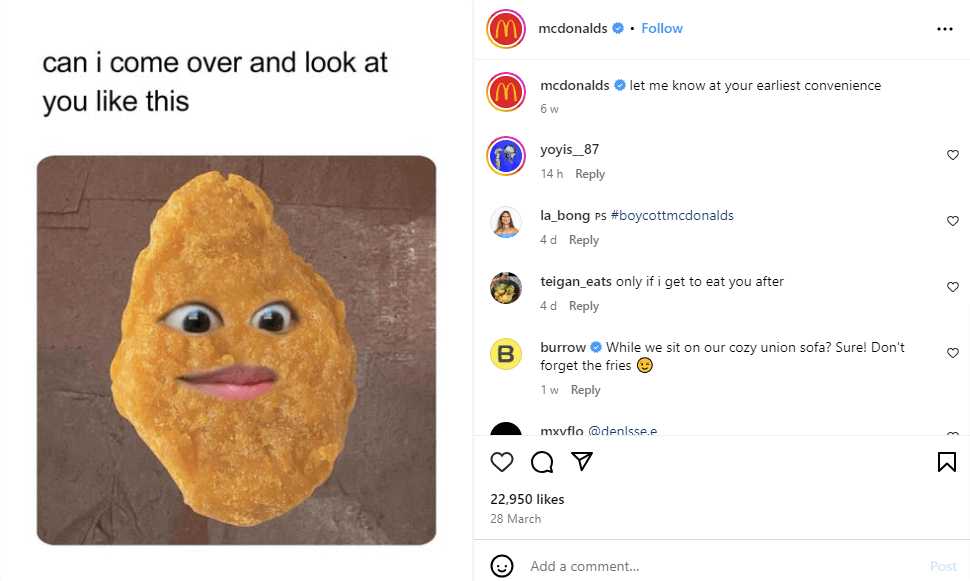
3. Snickers – bold, humorous
Snickers’ slogan, “You’re Not You When You’re Hungry,” clearly indicates their bold, straightforward, and humorous tone of voice.
It’s playful yet straightforward, making fun with the idea that you become someone else when you’re hungry. You can also see this in most of their adverts, which often feature someone acting abnormally because they’re hungry.
These ads use humor to convey that you must eat to function well.
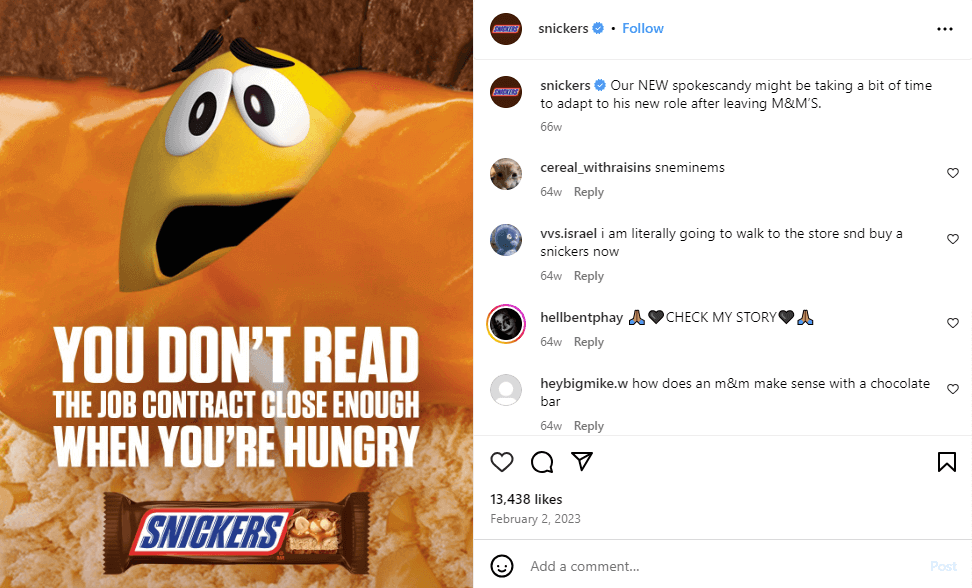
4. Fisherman’s Friend – friendly, casual
As a brand with a long history of producing time-tasted remedies for throat-related issues, Fisherman’s Friend echoes a friendly, casual, and straightforward tone of voice.
Their social media posts and adverts show how they use simple, casual words to communicate with their audience.
They’re also direct and go straight to the point in their brand messages, focusing on the efficacy of their products in relieving throat discomfort.
This post from Fisherman’s Friend on Instagram will give you a good idea of their brand tone.
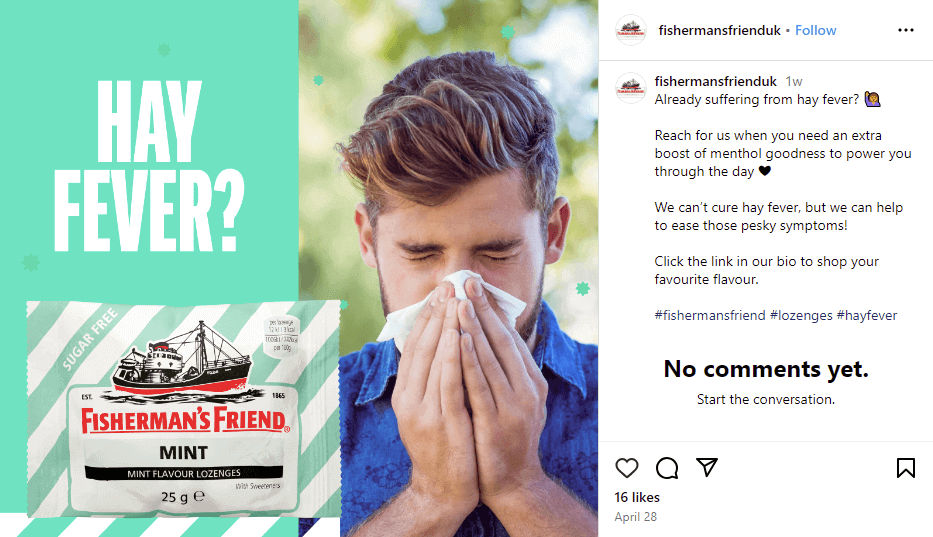
5. Louis Vuitton – sophisticated, formal
Louis Vuitton uses a formal, sophisticated, and informative brand tone in their messages. They communicate the perks of luxury and sophisticated fashion, painting a dream-like image.
You can see from their social media posts that they communicate a sense of privilege and prestige to their audience, as not everyone gets to wear Louis Vuitton.
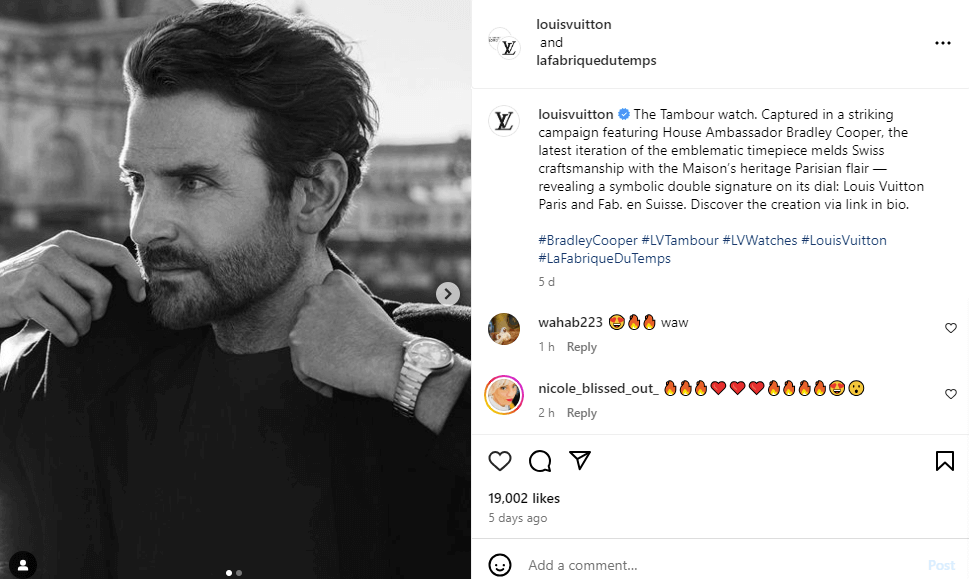
Here are some other examples of brand tone of voice:
- Dove – Supportive and empowering: Dove speaks kindly and positively. They focus on real people’s stories and celebrate everyone’s unique beauty, making people feel included and supported.
- Old Spice – Humorous and bold: Old Spice is known for being funny and bold. Their ads often have wild and exaggerated scenes that are fun to watch and remember, making the brand stand out.
- Tesla – Visionary and aspirational: Tesla’s messages are about new ideas and a brighter future. They talk about how their technology can change the world, aiming to excite people about new energy and cars.
- Ben & Jerry’s – Casual and socially aware: Ben & Jerry’s has a relaxed and friendly tone. They mix humor with serious talk about social issues, making their messages fun and meaningful.
- Airbnb – Welcoming and inspirational: Airbnb uses warm and inviting words to encourage exploration and sharing stories. They focus on helping people experience new places like locals.
- Lego – Playful and imaginative: Lego’s messages are fun and appeal to kids and adults. They inspire creativity and building, making everyone feel they can create something great.
How to define your brand tone of voice
Here are the detailed steps to define your brand’s tone of voice.
1. Know your audience
Understanding your audience is key to establishing a distinct tone of voice for your brand. Pay attention to their demographics, needs, and communication preferences.
This process will be more straightforward if you have an existing customer base. You can easily determine what tone of voice resonates with them by asking how they’d describe your brand and how they would like to be spoken to.
This will help you determine whether your current tone is appropriate for your audience and where changes are required.
2. Define your brand identity
Defining a tone of voice is almost impossible without defining your brand’s story, as it is the foundation of everything your brand stands for
Therefore, with a good knowledge of your audience, the next thing is to establish your brand’s core values, mission, and personality. Define what your brand stands for, what your story is, and identify your unique attributes and characteristics.

Take the Brand Clarity Audit
A reality check to uncover what's holding your brand and business back from the recognition and scale it deserves.
3. Conduct brand audits
If you have an existing brand and have been present online, you must identify what aspects of your communication are already effective and what needs to change to better align with your brand identity.
When you are consistent in your tone across all platforms, you are seen as a more reliable and professional brand.
Review existing communications, including marketing materials, social media posts, customer service interactions, etc.
Look for uniformity in the way you talk across these materials. Is the language similar on Facebook as it is in your emails? Do you sound like the same company?
Think about how your audience reacts to your messages. Do they engage well with a certain style or tone?
Look for gaps or inconsistencies in these communications and evaluate how you need to improve them.
4. Define your brand’s personality
This is a part of creating your brand identity, of defining your brand, but brand personality needs extra attention while determining your tone of voice.
A steady and consistent brand personality helps ensure that your messaging consistently reflects the same character and values. This makes your brand more recognizable and memorable to customers.
Identify three to five adjectives that best describe how you want your brand perceived (e.g., friendly, innovative, trustworthy).
Imagine a character that represents your brand, which helps to personify these traits. Think about how this character would speak and act.
For example, Old Spice is known for its witty and bold character, appealing to a young, fun-loving demographic through commercials and social media
5. Create brand voice guidelines
With the information gathered in the steps above, create brand voice guidelines that outline the critical elements of your brand’s tone of voice, including the traits, words, tone, and style.
Detailed guidelines ensure that everyone who communicates on behalf of your brand—whether through marketing materials, social media, or customer service—uses a consistent tone. And as we know, consistency helps to build a brand.
For each of your chosen adjectives, describe what they mean regarding how you communicate. Include dos and don’ts.
Decide how formal your language should be, whether you use slang, and how much industry jargon is appropriate. Indicate how to use punctuation to reflect your tone (e.g., casual tones might use more exclamation points).
Provide examples and case studies to illustrate each element, helping your team members maintain a consistent tone in their communication on different channels.
A comprehensive brand tone of voice guidelines has the following components:
- Brand personality traits
- Language and adjectives
- Voice tones
- Voice examples
- Dos and don’ts, etc.
6. Implement your tone of voice
Start using your newly defined tone of voice across all communications.
Outline a clear plan that specifies which platforms and types of communication will be updated with the new tone of voice.
This should include digital content (websites, social media), print materials (brochures, packaging), and internal communications (emails, internal documents).
If you have a team, ensure that everyone involved in content creation, from marketing to customer support, understands the guidelines and how to apply them.
7. Review and evolve
Keep track of how your audience reacts to different types of messages across various platforms. Use tools like social media analytics, customer feedback, and engagement metrics to assess the effectiveness of your tone of voice.
Your brand’s tone of voice may evolve over time as your brand grows and adapts to new challenges and opportunities. Ensure your tone of voice remains relevant and reflects any new brand values or changes in your audience.
Also, gather feedback from your customers, employees, and other stakeholders to assess how effectively your brand’s tone of voice is implemented and perceived. This can come from social media comments, customer service interactions, and team feedback.
This feedback can be a powerful guide in helping you review and refine your brand’s tone of voice.
Get started with defining your brand identity.

Take the Brand Clarity Audit
A reality check to uncover what's holding your brand and business back from the recognition and scale it deserves.
Brand tone of voice template
Want a step-by-step guide to setting the right tone for your brand?
Get this template and workbook: it will walk you through each step from understanding your audience to implementing your brand voice across various platforms.
Simply make a copy of this Google Doc and get started!
How to ensure consistency in your tone across all communication channels
A consistent brand tone of voice is essential for building and maintaining a solid relationship with your audience. To achieve consistency with your brand tone of voice across all communication channels, here are some vital tips:
- Develop clear guidelines: Create detailed guidelines describing your brand’s tone of voice, including specific dos and don’ts.
- Provide training and resources: Offer training sessions and educational materials to help your team effectively understand and use the brand tone.
- Monitor and enforce: Regularly check all communications across channels to ensure they align with your brand tone. Make adjustments as needed.
- Use templates and examples: Give your team templates and example content as references to help them consistently apply the brand tone.
- Gather feedback: Ask your customers about how they perceive your brand’s communications. Use their suggestions to refine your tone of voice.
Common mistakes to avoid when developing your brand tone of voice
Here are common mistakes you must avoid when developing your brand tone of voice to ensure consistency and effectiveness:
- Ignoring your target audience
- Switching between different tones or styles without a clear reason
- Not aligning your tone with your brand values
- Using complex language your audience is not familiar with
- Neglecting emotional connection
- Being too formal or too casual in your communications
- Failing to improve your tone based on the feedback
How to measure the effectiveness of your tone
It’s essential to regularly measure how well your brand tone of voice resonates with your target audience, aligns with your brand identity, and meets your communication goals.
Here are some key metrics you can use to measure the effectiveness of your brand tone of voice:
1. Audience engagement
If your audience engages well with your brand messaging, you know something is working.
Monitor audience engagement metrics, such as likes, shares, comments, and click-through rates, to determine the effectiveness of your brand tone of voice.
2. Surveys and feedback
Gather feedback from your audience through surveys, focus groups, or direct inquiries to assess their perceptions of your brand’s tone of voice.
You can ask questions about clarity, relatability, and emotional resonance to gain insights into how well your brand messaging connects with your audience.
3. Consistency across different channels
Assess the consistency of your brand tone across different communication channels and touchpoints.
Look for deviations from your brand guidelines and address them to ensure a consistent brand identity.
Conclusion
A well-defined brand tone of voice helps reinforce your identity, making your brand recognizable across every channel.
When imbibed by your team in every form of communication, including written and verbal, you can quantify its impact by measuring your engagements, content performance, and brand recognition.
Hopefully, you’ve learned why brand tone of voice is essential to your brand marketing and how to define it for consistent application across all channels.

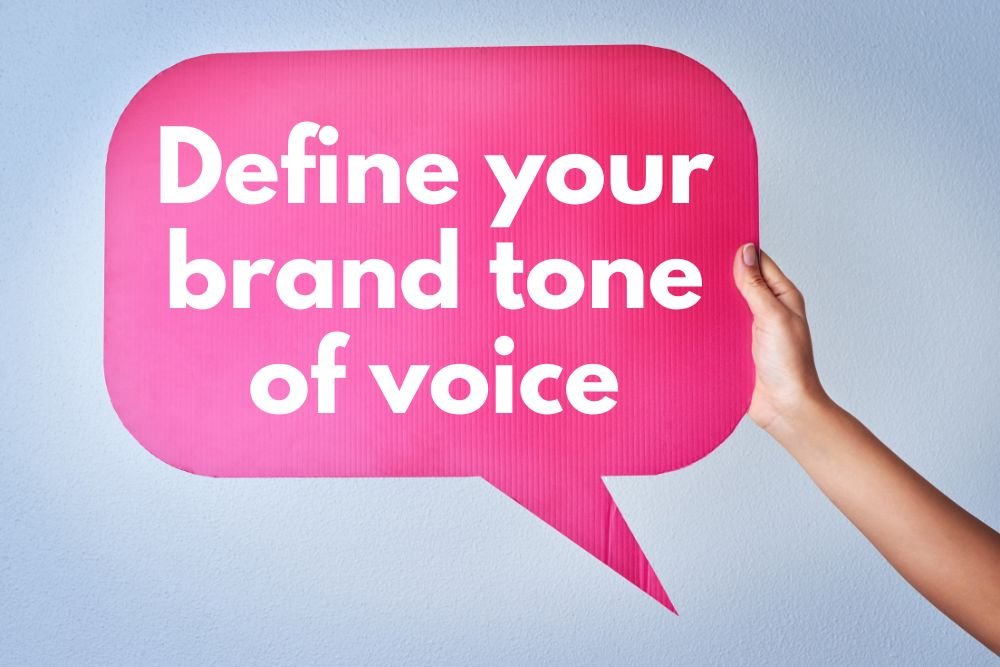


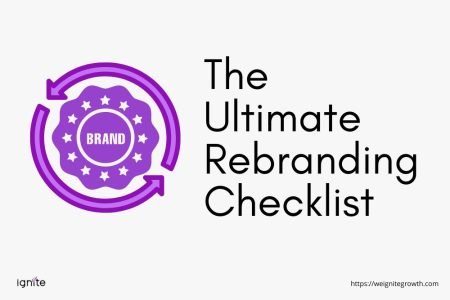



I’m impressed by how much valuable information you packed into this post.